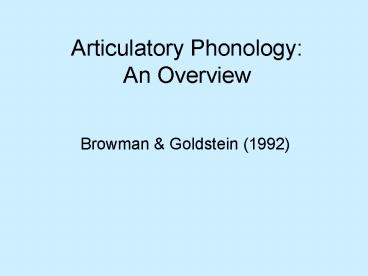Articulatory Phonology: An Overview - PowerPoint PPT Presentation
1 / 16
Title:
Articulatory Phonology: An Overview
Description:
distinguishable from forms with no alveolar stop gesture (lay call) ... alveolar closure gesture with the same. magnitude, but in fluent speech, it is ... – PowerPoint PPT presentation
Number of Views:91
Avg rating:3.0/5.0
Title: Articulatory Phonology: An Overview
1
Articulatory PhonologyAn Overview
- Browman Goldstein (1992)
2
Organisation of the Paper
- 1- The model
- 2- Application of the model to
- phonological variation
- allophonic variation
- Speech errors
- Speech development
3
The model
- The events - physical even happening in the
vocal - track in space
and over time. - - event are the
unfolding of articulatory - gestures.
- The gestures -a set of related vocal track
variables - that control
the a target vocal track -
constriction.
4
The model
- Gestures
- Organised in a coordinative structure
- Characterised dynamically as motion of track
variables, not of individual articulators
Track variables Dimensions that characterise a
local constriction articulator(s) involved in
constriction location of constriction degree of
constriction duration of constriction
5
The model
- The gesture is the primitive for contrast.
- Gestures can capture paradigmatic and syntagmatic
contrast
Paradigmatic contrast - inventory of gestures
- natural
classes are represented by
an articulatory (track
variable)
geometry. -
similar to, but not identical to
Feature Geometry.
6
The model
- Syntagmatic contrast
- Temporal organisation of gestures in lexical
items (gestural score) - Represented by tube geometry
- Categorical
- presence or absence of a given
gesture - different gesture composition
(based on track variable composition) - Gradient (quantal in terms of articulatory
acoustic relation) - variable target/degree of
constriction - dynamics trajectory, stiffness,
dampness.
7
The model
- Gestures are organised in Constellations
- Gesture composition tier based tubes
- Hierarchical structure phasing between gestures
8
The model
- Phasing allows for accounting for a variety of
phenomena
Three possible temporal relations between
gestures
- minimal overlap
- partial
overlap
- complete overlap
Utterances may have the same gesture composition,
but contrast in how gestures are organised
temporally
- n vs nd
- ht vs
th
Coarticulation, spreading assimilation are
(perceptual) consequences of different phasing
9
Application of the Model I Allophonic Variation
10
Application of the Model I Allophonic Variation
- Allophonic variation as gradient overlap
- a given set of gestures (VCV) may give
- raise to different types of variation
- if the gestures involve different vocal track
variables, e.g. idi, ada (TT vs TB) - - target gesture
achieved, with different articulatory - trajectories,
depending on the vowel (C? V) - - no difference
in consonant percept
- if gestures involve the same track variable,
e.g. aga, igi (TB) - - contradictory
same variable, different directions - - Location, not
degree, of constriction will vary as - a function of
vowel (C?V) - - May be
perceptible
11
Application of the Model I Allophonic Variation
- Allophonic variation as dynamic processes
Positional Reduction - Gesture may shrink in
time and
space in some contexts
- In these
contexts, metrical properties
of gestural events
are scaled, not altered
- Reduced gestures may or may not satisfy
perceptual - (categorical) conditions
- Reduction is multi-tiered velocity
- -
kinematics (displacement, duration, -
peak velocity)
12
Application of the Model I Allophonic Variation
Allophonic variation as dynamic processes English
aspiration
13
Application of the Model II Speech Errors
- The Act of Talking - Articulatory
implementation and acoustic -
consequence of invariant (lexical) gestures. -
- Performance??
Like allophonic variation
- Possesses active in the Act of Talking are
inherently gradient, but may - be perceived categorically
- Characterised by increased gesture overlap,
decreased gesture duration, - degree
- - assimilation
- - deletion (gesture
hiding)
Unlike allophonic variation
- processes generated by speech conditions rate,
formality, etc
14
Application of the Model II Speech Errors
- Assimilation Gestures are articulatorily
present, but may - be reduced to a variable
extent
late call Even with no alveolar
contact observed, perceptually
distinguishable from forms with no
alveolar stop gesture (lay call)
bad ban Even with the same amount of
overlap, there may me bab dan
asymmetrical direction of perceived assimilation
seven plus perceived assimilation to m,
but alveolar closure still present
15
Application of the Model II Speech Errors
- Deletion as Gesture Hiding
perfect memory Both in
fluent speech and isolation there is an
alveolar closure gesture with the same
magnitude, but in fluent speech, it is
completely overlapped by k and m
perceived deletion
Bob flew by Bligh Bay In fast
speech, there is diminution of l activity in
some contexts, increase in other. Few cases
have
Ø, few have full l Gradient
beret
A completely hidden schwa b_r is perceptually
different from a sequence with no input schwa
br.
16
Application of the Model III Developmental Data
- A childs first words are stored and retrieved
not as phonemes, but as holistic patterns of
articulatory routines
- Basic units of routines are discrete gestures
- that emerge pre-linguistically
- Coordination into segment-size units only
- appears gradually in the course of language
- acquisition
- - Cannot be distinguished
from Feature - Geometric approaches
same empirical - coverage.































